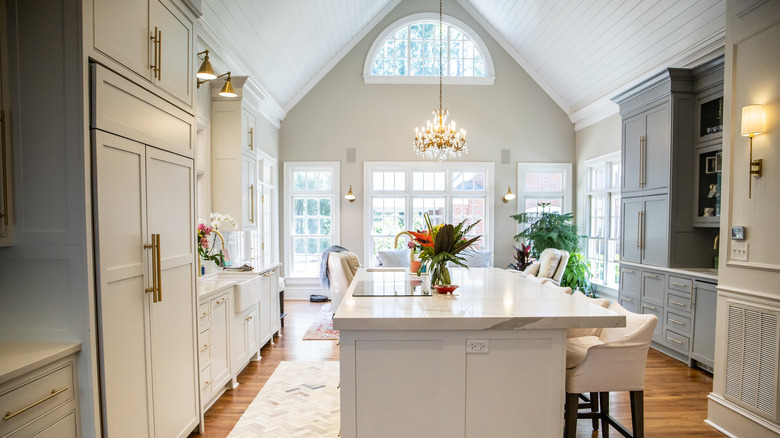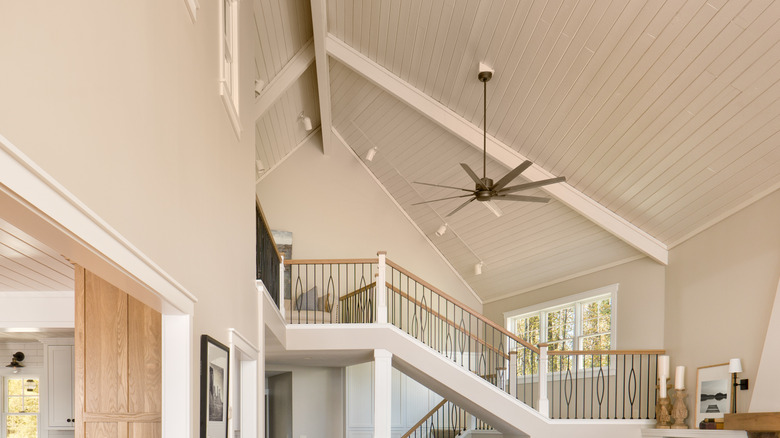The Pro Tip Erin Napier Suggests For Squeezing Every Inch Out Of A Small Home
Homeowners have to be smart about design to prevent a small home from feeling cramped. Tiny living spaces often require you to brainstorm ways to save room. You might opt for space-saving features like a bathroom pocket door or multi-purpose furniture. It also helps to use design tricks that make the rooms seem visually larger. During an episode of HGTV's "Home Town," co-host Erin Napier revealed that you can squeeze every inch out of a small home by vaulting the ceiling. The TV personality made the decision to add vaulted ceilings to a couple's living room on the show. "We're gonna vault the ceiling, which is very exciting," Napier said during the "Home Town" episode (via YouTube). "It's gonna make this little bitty house feel a lot bigger."
A vaulted ceiling is different from a traditional ceiling in that it is taller than eight to ten feet. These high ceilings typically include an arched center which can make a room look more sophisticated. If you want to get architecturally precise, vaulted ceilings are also different to cathedral ceilings: While vaulted ceilings create a rounded dome or tunnel, cathedral ceilings usually refer to any type of ceiling that is installed directly underneath the roof and echoes its pitch. However, like in this episode of "Home Town," these terms are often used interchangeably. Now that's out of the way, if you have a small home, here's why you should consider adding vaulted or cathedral ceilings to make the space feel larger and more open.
Vaulted ceilings make a small home feel vast
The finished living room with the upgraded vaulted ceilings shown in the "Home Town" episode is stunning. Viewers can instantly see that the room looks far larger thanks to the extra overhead space. Although the square footage did not increase, the vaulted ceiling still provides that illusion. It is no surprise that the homeowners were thrilled with the renovation.
With vaulted ceilings, you may also find that you have more room for decorative lighting fixtures that would not otherwise fit in your small home. With a cathedral ceiling and extra space to play with, you might consider installing a low-hanging chandelier in your bathroom, for example. This kind of lighting fixture can easily take up too much space in a small room with a low ceiling.
Rather than including vaulted ceilings in every room in your home, you will likely find it more beneficial to make the upgrade only where it is most appropriate. Vaulted ceilings should be installed between the structural beams in your roof, so take this into consideration when deciding where you want to include them. You might want to consider installing vaulted ceilings mainly in the high-traffic parts of your home that you use a lot, like your living room. However, you may also have smaller rooms that are perfect for a cathedral ceiling, such as a bathroom that's low on headroom.
Pros and cons of vaulted ceilings
Napier's vaulted ceiling recommendation will help those with small homes enjoy the feel of larger rooms. However, you should still weigh the pros and cons of the design feature before deciding whether or not vaulted ceilings are right for your home. Besides enlarging a room, vaulted ceilings can also allow you to bring more natural light into your space. Depending on how they are structured, homeowners may have enough room to add windows along the space where both sides of the ceiling turn inward to form an arch. These elevated windows can turn a dull room into a pool of sunlight.
Let's explore the downsides of vaulted ceilings so that you have a better idea of what to expect when having them installed. With such high ceilings, it can be difficult to clean and maintain the area and any lighting fixtures you have installed there. This design feature may also make it more difficult to heat rooms. Since hot air rises, warm air can accumulate high up, under the ceiling, while the rest of the room remains chilly. Lastly, having vaulted ceilings installed is costly. It is actually more expensive to upgrade an existing ceiling, costing anywhere from $18,000 to $35,000 to add the feature to a home. Vaulted ceilings are more cost-effective when incorporated into a new build, where they can cost anywhere from $16,000 to $21,000.


